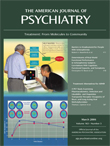Chronic Stress and Adaptation
To the Editor:
In the August 2005 issue of the Journal(1), Kathleen T. Brady, M.D., Ph.D., and Rajita Sinha, Ph.D., proposed a connection between substance abuse disorders and four commonly comorbid disorders: depression/mood disorders, posttraumatic stress disorder (PTSD), attention deficit hyperactivity disorder, and schizophrenia. The link offered is the neurobiological effect of chronic stress. This is a particularly timely contribution given that hundreds of thousands of new combat veterans are now in the deployment/redeployment cycle. Among their most common diagnoses are PTSD, major depression, and substance abuse.
This clustering of diagnoses raises the question of whether a single biological defect or set of defects can be identified as the lynchpin of traumatic stress. It remains unclear whether some individuals are biologically predisposed to one or more disorders based on preexisting vulnerabilities or if life experiences with specific psychological meanings endured under extreme social pressure (including the complex disruption of deployment and the intense bonding of soldiers under fire) alter otherwise fit neuroendocrine and neuroanatomical systems—right down to gene expression—to produce disorders of traumatic stress. Drs. Brady and Sinha did not identify a single factor but rather a complex system of primarily biological stress responses capable of producing different but sometimes overlapping clinical pictures in different individuals. This is a valuable perspective, but for a majority of new combat veterans, psychological, social, and adaptive factors (given short shrift by Drs. Brady and Sinha) deserve more attention.
Research findings suggest that about 20% of combat veterans develop a diagnosable mental disorder within the first few months of demobilization (2), but experience demonstrates that virtually all combat veterans face serious readjustment challenges. The practical problems of most returning veterans might be better understood, expressed, and discussed in terms of adaptive struggle rather than neurobiological illness. When soldiers return with hypervigilance, hyperarousal, intrusive traumatic memories, and emotional withdrawal, we might be of more help to them, their families, and their communities (including their military units) if we frame their current state as a necessary and even successful adaptation to deployment rather than a mental disorder.
PTSD and other disorders of extreme stress are serious medical conditions, but the line between postdeployment adaptation and illness is often obscure. For the majority of new veterans, readjustment problems have more to do with an evolving “goodness of fit” than with psychopathology. Readjustment takes time for most combat veterans, but we are still talking about adaptation rather than disorder. For soldier, family, community, clinician, and even scientist, readjustment might best be understood in terms of an ongoing dynamic balance. Drs. Brady and Sinha have teased out some of the biological underpinnings of that dynamic. More focus is needed on its psychological, social, and adaptational dimensions.
1. Brady KT, Sinha R: Co-occurring mental and substance use disorders: the neurobiological effects of chronic stress. Am J Psychiatry 2005; 162:1483–1493Link, Google Scholar
2. Hoge CW, Castro CA, Messer SC, McGurk D, Cotting DI, Koffman RL: Combat duty in Iraq and Afghanistan, mental health problems, and barriers to care. N Engl J Med 2004; 351:13–22Crossref, Medline, Google Scholar



